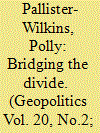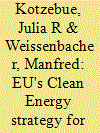| Srl | Item |
| 1 |
ID:
138984


|
|
|
|
|
| Summary/Abstract |
Building on a long history of spatial control through walling in the region, walls and fences have been built in the Middle East in recent years to undertake a range of practices. Gated communities, residential and security compounds, anti-migrant walls, separation barriers and counter-insurgency fences can all be found in the Middle East. These walls address and govern problems that take the population as their subject. These walls all share a common frame of viewing the populations they work to govern as ‘problematic’ in multiple ways. This paper explores how walls have been and continue to be used in governing populations through mobility and incorporating a combination of disciplinary and biopolitical techniques through a range of spatial and territorial repertoires. As such it works to bridge the divide in border studies and critical security studies between geopolitical/topographical and biopolitical/topological approaches to borders and governance.
|
|
|
|
|
|
|
|
|
|
|
|
|
|
|
|
| 2 |
ID:
176703


|
|
|
|
|
| Summary/Abstract |
The European Union has more than 2200 inhabited islands. Many keep relying on fossil fuel-based energy systems, even though they are endowed with renewable energy resources (RES) and have access to gradually improving renewable energy technologies. In May 2017 the EU Commission and 14 member states with island territories signed the so-called “Valletta Declaration” in Malta's capital. The declaration states that islands can be favorable for innovative solutions and investments in local renewable energy production, given the abundance of various RES. However, the island nation of Malta features very low renewable energy shares within the EU. The Energy transition theory in the field of sustainable transition studies explains social and technological system-wide evolution and innovation, but only few scholars have focused on spatial governance in islands’ energy transition. Malta's urbanization rate is about 95%, which creates a spatially extreme situation. The policy perspective clarifies the role of spatial governance in Malta's energy transition from a fossil fuel-based to a non-fossil fuel-based country. A theoretical spatial governance framework guides the analysis. The perspective highlights that Malta's centralized and hierarchical spatial governance structure creates an environment, in which the spatial situation is used to argue against small and de-centralized renewable technologies.
|
|
|
|
|
|
|
|
|
|
|
|
|
|
|
|
| 3 |
ID:
186944


|
|
|
|
|
| Summary/Abstract |
Using ethnographic data gathered in Beijing during 2017 and 2018, this article examines numerous urban population displacement events using the concept of spatial governance in order to understand the spatialization of governance in urban China. A particular focus of this article are the Beijing-wide displacements of the so-called “low-end population” that followed a fire in Xinjian Village in 2017. The analysis in this article uses geographic understandings of spatial informality to interrogate how space is made informal and subsequently illegal as a means of population control. The article puts forward the idea that spatial governance is one of the key forms, if not the key form, of governance in urban China. It highlights changes in governance that have resulted in space becoming not just a site for control, but the medium for techniques of control over China's urban population.
|
|
|
|
|
|
|
|
|
|
|
|
|
|
|
|